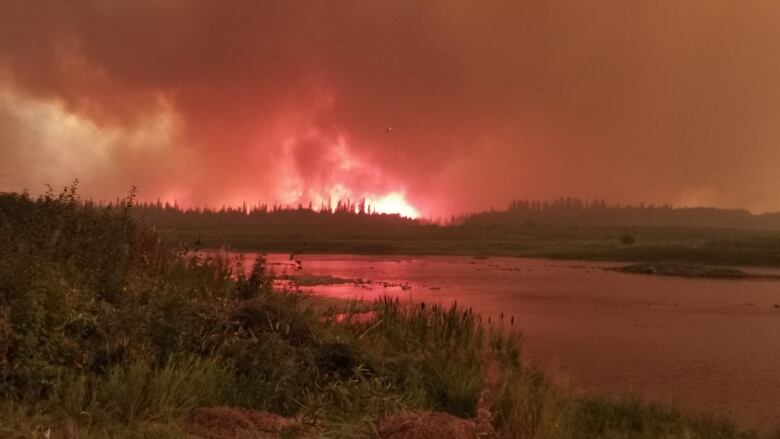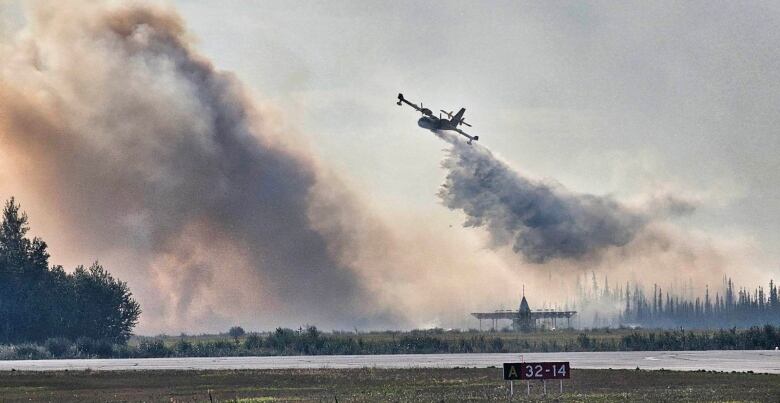More personnel now working Hay River wildfire than ones near Yellowknife
Number of firefighters attacking Yellowknife area wildfires has been reduced 'considerably,' says N.W.T. Fire

Despite criticism from an N.W.T. First Nations community about firefighting resources, a spokesperson for the territory's wildfire response efforts says crews have "absolutely" been redeployed to Hay River and the Kt'odeeche First Nation as the wildfire near those communities has progressed.
"It's not fair, they're only focusing on Yellowknife," said Kt'odeecheFirst Nation (KFN) Chief April Martel of theallocation of firefighting personnel in an interview with CBC News on Saturday.
Martel said fire crews and military personnel stationed near Yellowknife were told "they could go home."
"They sent everybody back home, not even thinking they could send all the crews to Hay River and Fort Smith and help us out, they didn't do that," said Martel.

Fewer crews in Yellowknife
But N.W.T. Fire information officer Mike Westwick says that's not entirely the case, and that the deployment of crews and equipment"is not a numbers game."
"It is about having the right people for the tactics you intend to use. We have had, and continue to have, the firefighters and expertise necessary to execute the tactics necessary to manage [the Hay River/KFN] fire."
For example, he said, in many areas of the North Slave Complex (which includes the fires that threatened Yellowknife,Behchok, Ndil and Dettah) the use of heavy equipment wasn't an option because of the Canadian Shield topography and the lack of road access.
"When you can't use as much heavy equipment to dig away fire line, you need more people power," he said.
In Hay River, he added, "you have a fire with road access in key areas across the fire area, and you're off the shield so you're able to use heavy equipment in more parts of the fire."

In an update provided to CBC News on Sunday, Westwick confirmed the number of firefighters attacking the Yellowknife area wildfires has been reduced "considerably" as the active fire areas move toward the mop-up stage.
Right now, Westwick said,there are more personnel working on the wildfires threatening Hay River and the Kt'odeeche First Nation than in the Yellowknife area.
"We have had members of the team move from Yellowknife to Hay River as the fire has progressed, absolutely," he said. "Aircraft as well."
Westwickalso said numerous pieces of heavy equipment were added to the Hay River fire in the last week.
'Work-rest' periods at play
Westwickalso said the Canadian Armed Forces which added to the numberof personnel working on the Yellowknife-area fires at their peak are only able to take on basic tasks, like mop-up.
The fires around Hay River and the Kt'odeecheFirst Nation reserve remain "highly active," meaning they aren't at a mop-up stage, said Westwick.

In a post on Sunday, the N.W.T. Fire Facebook page shared a photo thanking Yukon crews who are headed home this weekend.
"Thanking our northern neighbours for their help!" the post reads. "Crews from the Yukon are returning home after helping our firefighters in the North Slave."
Westwick sayscrew shifts do not mean dwindling numbers of firefighters in an area.
"We ensure we stick to a work-rest period so firefighters are not fatigued and are able to work safely."












_(720p).jpg)


 OFFICIAL HD MUSIC VIDEO.jpg)
.jpg)



























































































